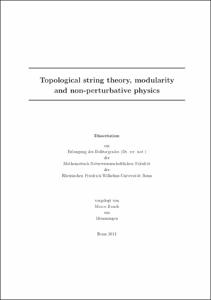Topological string theory, modularity and non-perturbative physics

Topological string theory, modularity and non-perturbative physics

| dc.contributor.advisor | Klemm, Albrecht | |
| dc.contributor.author | Rauch, Marco | |
| dc.date.accessioned | 2020-04-17T07:32:19Z | |
| dc.date.available | 2020-04-17T07:32:19Z | |
| dc.date.issued | 28.09.2011 | |
| dc.identifier.uri | https://hdl.handle.net/20.500.11811/5039 | |
| dc.description.abstract | In this thesis the holomorphic anomaly of correlators in topological string theory, matrix models and supersymmetric gauge theories is investigated. In the first part it is shown how the techniques of direct integration known from topological string theory can be used to solve the closed amplitudes of Hermitian multi-cut matrix models with polynomial potentials. In the case of the cubic matrix model, explicit expressions for the ring of non-holomorphic modular forms that are needed to express all closed matrix model amplitudes are given. This allows to integrate the holomorphic anomaly equation up to holomorphic modular terms that are fixed by the gap condition up to genus four. There is an one-dimensional submanifold of the moduli space in which the spectral curve becomes the Seiberg-Witten curve and the ring reduces to the non-holomorphic modular ring of the group G(2). On that submanifold, the gap conditions completely fix the holomorphic ambiguity and the model can be solved explicitly to very high genus. Using these results it is possible to make precision tests of the connection between the large order behavior of the 1/N expansion and non-perturbative effects due to instantons. Finally, it is argued that a full understanding of the large genus asymptotics in the multi-cut case requires a new class of non-perturbative sectors in the matrix model. In the second part a holomorphic anomaly equation for the modified elliptic genus of two M5-branes wrapping a rigid divisor inside a Calabi-Yau manifold is derived using wall-crossing formulae and the theory of mock modular forms. The anomaly originates from restoring modularity of an indefinite theta-function capturing the wall-crossing of BPS invariants associated to D4-D2-D0 brane systems. The compatibility of this equation with anomaly equations previously observed in the context of N=4 topological Yang-Mills theory on P2 and E-strings obtained from wrapping M5-branes on a del Pezzo surface which in turn is related to topological string theory is shown. The non-holomorphic part is related to the contribution originating from bound-states of singly wrapped M5-branes on the divisor. In examples it is shown that the information provided by the anomaly is enough to compute the BPS degeneracies for certain charges. | en |
| dc.language.iso | eng | |
| dc.rights | In Copyright | |
| dc.rights.uri | http://rightsstatements.org/vocab/InC/1.0/ | |
| dc.subject.ddc | 530 Physik | |
| dc.title | Topological string theory, modularity and non-perturbative physics | |
| dc.type | Dissertation oder Habilitation | |
| dc.publisher.name | Universitäts- und Landesbibliothek Bonn | |
| dc.publisher.location | Bonn | |
| dc.rights.accessRights | openAccess | |
| dc.identifier.urn | https://nbn-resolving.org/urn:nbn:de:hbz:5N-26479 | |
| ulbbn.pubtype | Erstveröffentlichung | |
| ulbbnediss.affiliation.name | Rheinische Friedrich-Wilhelms-Universität Bonn | |
| ulbbnediss.affiliation.location | Bonn | |
| ulbbnediss.thesis.level | Dissertation | |
| ulbbnediss.dissID | 2647 | |
| ulbbnediss.date.accepted | 19.09.2011 | |
| ulbbnediss.fakultaet | Mathematisch-Naturwissenschaftliche Fakultät | |
| dc.contributor.coReferee | Förste, Stefan |
Dateien zu dieser Ressource
Das Dokument erscheint in:
-
E-Dissertationen (4379)




